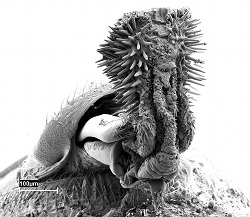Hundreds of deletions in non-coding DNA have helped sculpt human evolution, including an increase in brain size and the loss of sensory whiskers and penis spines, proposes a study published this week in linkurl:Nature.;http://www.nature.com/nature
"The molecular basis of becoming human is one of the great problems in biology," said senior author linkurl:David Kingsley;http://kingsley.stanford.edu/ of Stanford University. "There have been suggestions from multiple organisms that changes in non-coding regions were likely to be important," he added, and with the availability of the human genome sequence, "we have an incredibly exciting opportunity to start to address that question." For over a decade, Kingsley's lab has studied the genetic basis of evolution in stickleback fish, and found time and again that major morphological differences can be tracked to deletions in regions of DNA surrounding key developmental genes. To see...
 |
linkurl:Wikimedia Commons, Johanna Ronn;http://commons.wikimedia.org/wiki/File:Callosobruchus_analis_penis.jpg |
The Scientist.GADD45G, McLean, C.Y., et al., "Human-specific loss of regulatory DNA and the evolution of human-specific traits," Nature, 471:216-9.
Interested in reading more?
Become a Member of
Receive full access to more than 35 years of archives, as well as TS Digest, digital editions of The Scientist, feature stories, and much more!
Already a member?